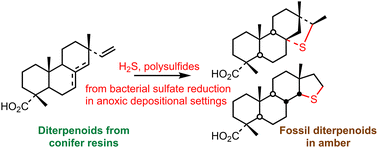Sulfurized diterpenoids in amber as diagenetic indicators of sulfate-reducing processes in past depositional environments†
Abstract
Two novel compounds isolated from an amber sample from the Santonian of Piolenc (Vaucluse, SE France) were identified using nuclear magnetic resonance and high-resolution mass spectrometry as sulfurized analogues of diterpenic acids from the isopimaric series originating from ancient conifers possibly related to the Cupressaceae family. These two compounds are members of a diterpenoid series corresponding to early diagenetic transformation products of resin diterpenoids. They were likely formed once plant resin comes into contact with reduced sulfur species originating from bacterial sulfate reduction occurring in anaerobic settings such as mangroves or marshes. They represent the first evidence of sulfurization processes affecting plant resin prior to diagenetic transformation into amber. Given their mode of formation, these compounds may be used as indicators of sulfate-reducing processes in past depositional environments.



 Please wait while we load your content...
Please wait while we load your content...